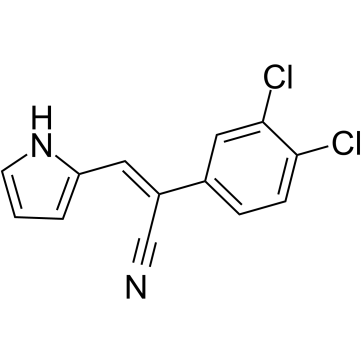ANI-7 is an activator of aryl hydrocarbon receptor (AhR) pathway. ANI-7 inhibits the growth of multiple cancer cells, and potently and selectively inhibits the growth of MCF-7 breast cancer cells with a GI50 of 0.56 μM. ANI-7 induces CYP1-metabolizing mono-oxygenases by activating AhR pathway, and also induces DNA damage, checkpoint Kinase 2 (Chk2) activation, S-phase cell cycle arrest, and cell death in sensitive breast cancer cell lines[1][2][3].<br>ANI-7 (2.5 μM; 24 hours; MCF10A and MDA-MB-468 cells) treatment induces significant S-phase and G2 + M-phase cell cycle arrest within 24 hours of treatment in MDA-MB-468 cells, and negligible effect in normal breast MCF10A cells[1].
ANI-7 (2 μM; 12-24 hours; MDA-MB-468 cells) treatment results in a significant increase in the content and phosphorylation of CHK2, and induces a significant increase in H2AXɣ in MDA-MB-468 cells, indicative of DNA double-strand damage[1].
Inhibition of the AhR pathway ameliorates the effects of ANI-7. ANI-7 activates XRE activity and expression of the AhR and CYP1 members[1].
Comparisons of the GI50 values show that ANI-7 produces a GI50 value of 0.38 μM in MCF-7 cells, whereas values of 3.0-42 μM are observed in cell lines from lung, colon, ovary, neuronal, glial, prostate, and pancreas. The only other tumor type that shows appreciable growth inhibition by ANI-7 is the A431 vulva cell line (GI50 of 0.51μM)[1][1].
ANI-7 potently inhibits the growth of T47D, ZR-75-1, MCF-7, SKBR3, and MDA-MB-468 breast cancer cells (GI50 range of 0.16-0.38 μM), moderately inhibits the growth of BT20 and BT474 cells (GI50 range of 1-2 μM), and essentially fails to inhibit the growth of MDA-MB-231 and MCF10A cells (GI50 range of 17-26 μM). Moreover, ANI-7 maintained its ability to inhibit the growth of drug-resistant cells (MCF-7/VP16: GI50 of 0.21 μM)[1].

